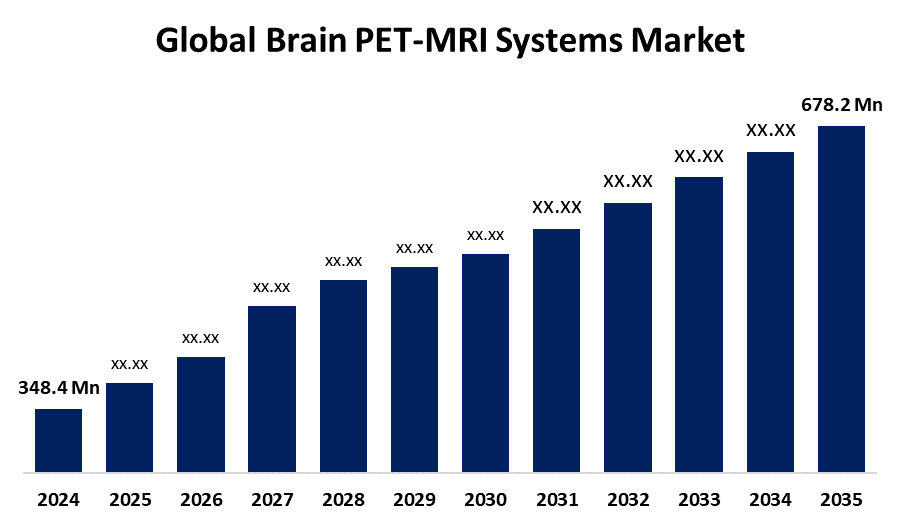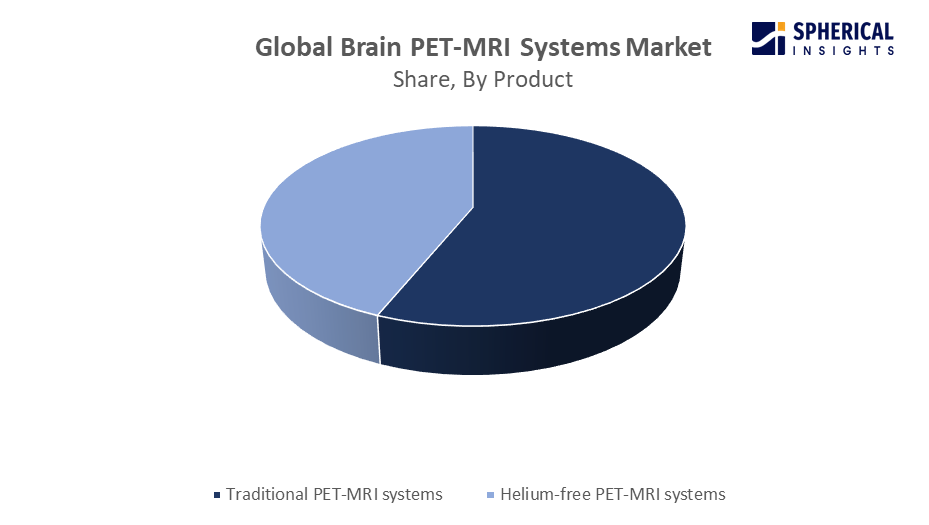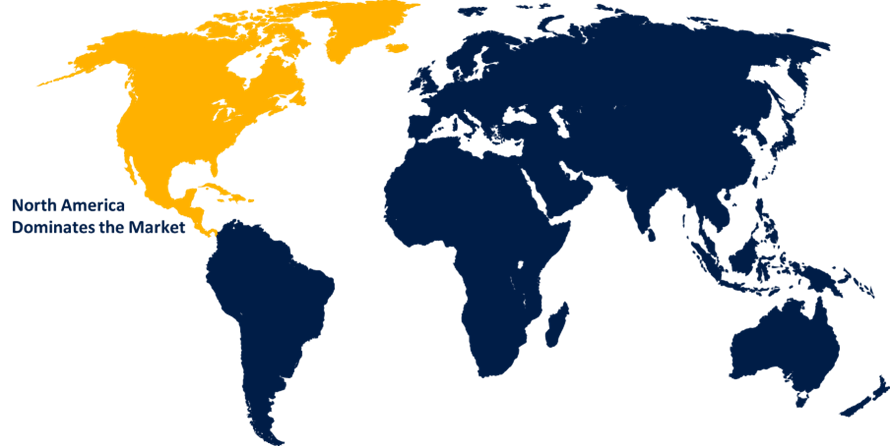Global Brain PET-MRI Systems Market Size, Share, and COVID-19 Impact Analysis, By Product (Traditional PET-MRI systems and Helium-free PET-MRI systems), By End-Use (Hospitals, Diagnostic Imaging Centers, and Others), By Region (North America, Europe, Asia-Pacific, Latin America, Middle East, and Africa), Analysis and Forecast 2025 - 2035
Industry: HealthcareGlobal Brain PET-MRI Systems Market Insights Forecasts to 2035
- The Global Brain PET-MRI Systems Market Size Was Estimated at USD 348.4 Million in 2024
- The Market Size is Expected to Grow at a CAGR of around 6.24% from 2025 to 2035
- The Worldwide Brain PET-MRI Systems Market Size is Expected to Reach USD 678.2 Million by 2035
- Asia Pacific is expected to Grow the fastest during the forecast period.

Get more details on this report -
According to a Research Report Published by Spherical Insights and Consulting, The Global Brain PET-MRI Systems Market Size was Valued at Approximately USD 348.4 Million in 2024 and is projected to Grow from USD 370.2 Million in 2025 to around USD 678.2 Million by 2035 with a compound annual growth rate (CAGR) of 6.24% from 2025 to 2035. The main reason that positron emission tomography is used in neurology is that it allows for clear three-dimensional images of molecular, physiological, and functional targets. To accurately align with anatomical structures and pathological changes, PET scanners are often used with other imaging modalities, most commonly an MRI.
Global Brain PET-MRI Systems Market Forecast and Revenue Outlook
- 2024 Market Size: USD 348.4 Million
- 2035 Projected Market Size: USD 678.2 Million
- CAGR (2025-2035): 6.24%
- North America: Largest market in 2024
- Asia Pacific: Fastest growing market
Market Overview
The brain PET-MRI systems market involves the creation, marketing, and usage of hybrid imaging equipment that integrates MRI and PET technologies for sophisticated brain diagnoses in clinical and research settings. The marketplace for brain PET-MRI systems is experiencing growth due to the increasing incidence of neurological diseases, the demand for less invasive diagnostic tests, and technological developments. Notable trends include hybrid imaging, portable systems, and AI integration. Increasing healthcare expenditures, an increasingly aged population, and providing personalised medicine are driving the demand for accurate non-invasive methods in neurology and oncology. In neurology, PET and MRI represent a powerful hybrid imaging procedure to provide structural and functional information about the brain. PET measures biochemical events, and MRI provides extensive morphological information on vascular supply, perfusion, edema, and functional activation. Conjoined, these procedures significantly improve the diagnosis of neurological disorders. PET-MRI systems are becoming increasingly popular in the clinic for simultaneous multiparametric scans, and as of 2017, there were approximately 30 PET-MRI machines in use in the United States in human and animal research. The advent of ultra-high-resolution 7T scanners has enabled advanced explorations of brain structure and function at an unprecedented level of detail, providing anatomically and functionally 50 times the detail compared to typical 3T scanners. Applications for preclinical imaging are also rapidly expanding. The Shenzhen Institute of Advanced Technology (SIAT) has developed the bPET, a highly sensitive and spatially detailed MRI-compatible brain PET scanner that is a breakthrough in hybrid neuroimaging technology for enhanced diagnostics using dual-ended readout depth encoding detectors.
Key Market Insights
- North America is expected to account for the largest share in the Brain PET-MRI Systems Market during the forecast period.
- In terms of product, the traditional PET-MRI systems segment is projected to lead the Brain PET-MRI Systems Market throughout the forecast period
- In terms of end use, the hospitals segment captured the largest portion of the market
Brain PET-MRI Systems Market Trends
- Precision in diagnosis and image analysis is being improved by AI and machine learning.
- Simultaneous structural and functional brain imaging is possible with hybrid PET-MRI systems.
- Clinical usage of mobile and portable PET-MRI equipment is growing.
- Neuroimaging capabilities are being advanced by ultra-high-resolution imaging (7T MRI).
- The market is expanding due to growing utilisation in neurological research and preclinical investigations.
Report Coverage
This research report categorizes the brain PET-MRI systems market based on various segments and regions, forecasts revenue growth, and analyzes trends in each submarket. The report analyzes the key growth drivers, opportunities, and challenges influencing the brain PET-MRI systems market. Recent market developments and competitive strategies, such as expansion, type launch, development, partnership, merger, and acquisition, have been included to draw the competitive landscape in the market. The report strategically identifies and profiles the key market players and analyzes their core competencies in each sub-segment of the brain PET-MRI systems market.
Global Brain PET-MRI Systems Market Report Coverage
| Report Coverage | Details |
|---|---|
| Base Year: | 2024 |
| Market Size in 2024: | USD 348.4 Million |
| Forecast Period: | 2025-2035 |
| Forecast Period CAGR 2025-2035 : | 6.24% |
| 2035 Value Projection: | USD 678.2 Million |
| Historical Data for: | 2020-2023 |
| No. of Pages: | 245 |
| Tables, Charts & Figures: | 110 |
| Segments covered: | By Product, By End-Use and COVID-19 Impact Analysis |
| Companies covered:: | Siemens Healthineers AG, Koninklijke Philips N.V., GE Healthcare, Bruker, Mediso Ltd., MR Solutions, Cubresa Inc., Aspect Imaging, Esaote, Mindray, Lanonics, Skylight Medical Technologies, Philips Healthcare, Hitachi, Toshiba Medical Systems, and Others |
| Pitfalls & Challenges: | Covid-19 Empact, Challenges, Growth, Analysis. |
Get more details on this report -
Driving factors:
The prevalence of neurological disorders in pets is on the rise, and technological advancements
The rising prevalence of neurological diseases in companion animals, especially older pets, is driving the global market for brain PET-MRI systems. These diseases that affect the brain and neurological system often necessitate advanced diagnostic equipment such as magnetic resonance imaging (MRI). Improvements in the image quality, scanning speed, and comfort of pets have come from the development of open MRI scanners and other technological innovations. Enhanced software has also helped improve accurate diagnosis. The efforts of outreach and education campaigns have also contributed to the growing recognition by pet owners regarding advanced veterinary care and animal accessible MRIs, significantly impacting MRI use in veterinary clinics across many regions of the global market.
Restraining Factor:
Expensive and hardly available
The considerable cost of brain PET–MRI devices still poses a significant hurdle for widespread applications in veterinary use, despite increasing demand. These advances in imaging technology are costly to install, operate, and maintain, which may be a challenge for smaller clinics and/or clinics in resource-limited countries. There are also not enough qualified veterinary radiologists and/or technicians to deploy these devices. These operational costs and budgetary limitations may limit overall market growth for the brain PET–MRI market, especially in rural areas and due to budget limitations.
Market Segmentation
The global Brain PET-MRI Systems market is divided into product and end use.
Global Brain PET-MRI Systems Market, By Product:
Why is the traditional PET-MRI systems segment expected to generate the highest revenue in the global Brain PET-MRI Systems (CBCT) market during the forecast period?
The traditional PET-MRI systems segment led the brain PET-MRI systems market, generating the largest revenue share. The traditional category of PET-MRI systems is forecasted to have the highest revenue generation owing to the current infrastructure in advanced healthcare settings, strong acceptance within the clinical community, and demonstrated diagnostic efficacy and effectiveness for neurological imaging. Clinical facilities and research institutions regularly utilize these modalities since they have been shown to provide reliable, high-quality imaging for imaging the brain. During the forecasted period, this category will benefit from the existing workflows and associated demand.

Get more details on this report -
The helium-free PET-MRI systems segment in the brain PET-MRI systems market is expected to grow at the fastest CAGR over the forecast period. The market for helium-free PET-MRI systems is anticipated to expand at the fastest rate because of its lower operating costs, less maintenance, and more environmentally friendly nature. The removal of helium dependency makes these systems more useful and economical for medical institutions, which propels market expansion and quick acceptance over the course of the projection period.
Global Brain PET-MRI Systems Market, By End Use:
What factors make hospitals the dominant segment in terms of market share during the forecast period in the global Brain PET-MRI Systems (CBCT) market?
The hospitals segment held the largest market share in the brain PET-MRI systems market. The incidence of multiple sclerosis, brain tumours, and amyotrophic lateral sclerosis has been increasing due to a growing incidence of neurological illnesses and a higher demand for extensive brain imaging. These conditions often require diagnostic imaging that is complex and expensive, and may only be available in hospitals. Hospitals sense a persistent need to ensure accurate diagnosis driven by the surge in neurological patients, and so are increasingly incorporating brain PET-MRI systems into their institutions to improve the diagnosis and management of neurological disorders.
The diagnostic imaging centers segment in the brain PET-MRI systems market is expected to grow at the fastest CAGR over the forecast period. The diagnostic imaging centers segment is projected to have the fastest CAGR as demand for specialized and accessible imaging services specific to the brain increases. The increase in the segment is being driven by cost-efficient alternatives, the use of more advanced technologies, and an enhanced focus on outpatient services that rapidly accelerate the brain PET-MRI systems market.
Regional Segment Analysis of the Global Brain PET-MRI Systems Market
- North America (U.S., Canada, Mexico)
- Europe (Germany, France, U.K., Italy, Spain, Rest of Europe)
- Asia-Pacific (China, Japan, India, Rest of APAC)
- South America (Brazil and the Rest of South America)
- The Middle East and Africa (UAE, South Africa, Rest of MEA)
North America Brain PET-MRI Systems Market Trends

Get more details on this report -
What factors contribute to the North America region holding the largest share of the global Brain PET-MRI Systems market during the forecast period?
North America is the predominant player in the brain PET-MRI systems (CBCT) market due to the region's strong healthcare infrastructure, high healthcare spending, and growing use of sophisticated diagnostic equipment in research facilities and academic institutions. The region's market leadership is further reinforced by extensive research and development efforts, the presence of top neuroimaging technology manufacturers, and esteemed research institutes.
Why does the United States lead the North American Brain PET-MRI Systems market?
The advanced healthcare system and strong demand for diagnostic imaging services, coupled with technological advancements, enable the United States to hold a leading position in the North American market for brain PET-MRI systems. Additionally, the U.S. is characterized by numerous universities, medical institutions, and research organizations pursuing neuroscience research, driving innovation and implementation across the country of new brain PET-MRI systems.
Asia Pacific Brain PET-MRI Systems Market Trends
How is the Asia Pacific region expected to be the fastest-growing Brain PET-MRI Systems market with the fastest growth rate?
The Asia Pacific region is expected to experience the fastest growth in the brain PET-MRI systems market, due to the increasing burden of neurological disorders, the increasing costs of healthcare, the continuing development of diagnostics infrastructure, and the national support schemes for medical imaging. The growing clinical and research needs in China, India, and Japan has contributed to faster adoption rates in those markets, while local sources have made it more affordable to source products.
Competitive Analysis:
The report offers the appropriate analysis of the key organizations/companies involved within the global brain PET-MRI systems market, along with a comparative evaluation primarily based on their type of offering, business overviews, geographic presence, enterprise strategies, segment market share, and SWOT analysis. The report also provides an elaborate analysis focusing on the current news and developments of the companies, which includes type development, innovations, joint ventures, partnerships, mergers & acquisitions, strategic alliances, and others. This allows for the evaluation of the overall competition within the market.
Worldwide Top Key Players in The Brain PET-MRI Systems Market Include
- Siemens Healthineers AG
- Koninklijke Philips N.V.
- GE Healthcare
- Bruker
- Mediso Ltd.
- MR Solutions
- Cubresa Inc.
- Aspect Imaging
- Esaote
- Mindray
- Lanonics
- Skylight Medical Technologies
- Philips Healthcare
- Hitachi
- Toshiba Medical Systems
- Others
Key Target Audience
- Market Players
- Investors
- End-users
- Government Authorities
- Consulting and Research Firm
- Venture capitalists
- Value-Added Resellers (VARs)
Recent development
- In November 2024, the FDA approved GE HealthCare's (GEHC) 3-tesla MRI scanner, the Signa Magnus, which is intended for head imaging. By decreasing the inner diameter, this system's asymmetrical, head-only gradient coil design improves gradient performance. By moving the gradient isocenter to the patient's edge, the creative design enhances head access and gets rid of shoulder width restrictions.
- In October 2024, the FDA authorised AiMIFY, a combined AI-powered imaging program developed by Bracco Diagnostics and Subtle Medical, a deep learning technology startup, as a Class II medical device for brain MRI images. The program may double the contrast obtained with a typical dosage of gadolinium-based contrast agents by using artificial intelligence (AI) to improve contrast in brain MRIs.
- In February 2024, Philips announced the launch of smart quant neuro 3D, an AI-based quantitative brain imaging in MR. The recently launched product offers powerful tools for greater diagnostic confidence to healthcare providers.
Market Segment
This study forecasts revenue at the global, regional, and country levels from 2020 to 2035. Spherical Insights has segmented the brain PET-MRI systems market based on the following segments:
Global Brain PET-MRI Systems Market, By Product
- Traditional PET-MRI systems
- Helium-free PET-MRI systems
Global Brain PET-MRI Systems Market, By End-Use
- Hospitals
- Diagnostic Imaging Centers
- Others
Global Brain PET-MRI Systems Market, By Regional Analysis
- North America
- US
- Canada
- Mexico
- Europe
- Germany
- UK
- France
- Italy
- Spain
- Russia
- Rest of Europe
- Asia Pacific
- China
- Japan
- India
- South Korea
- Australia
- Rest of Asia Pacific
- South America
- Brazil
- Argentina
- Rest of South America
- Middle East & Africa
- UAE
- Saudi Arabia
- Qatar
- South Africa
- Rest of the Middle East & Africa
Frequently Asked Questions (FAQ)
-
1. What is the CAGR of the Brain PET-MRI Systems market over the forecast period?The global Brain PET-MRI Systems market is projected to expand at a CAGR of 6.24% during the forecast period.
-
2. What is the market size of the Brain PET-MRI Systems market?The global Brain PET-MRI Systems market size is expected to grow from USD 348.4 million in 2024 to USD 678.2 million by 2035, at a CAGR 6.24% of during the forecast period 2025-2035.
-
3. Which region holds the largest share of the Brain PET-MRI Systems market?North America is anticipated to hold the largest share of the Brain PET-MRI Systems market over the predicted timeframe.
-
4. Who are the top 10 companies operating in the global Brain PET-MRI Systems market?Siemens Healthineers AG, Koninklijke Philips N.V., GE Healthcare, Bruker, Mediso Ltd., MR Solutions, Cubresa Inc., Aspect Imaging, Esaote, and Mindray
-
5. What factors are driving the growth of the Brain PET-MRI Systems market?The increase in neurological disorders (Alzheimer's, Parkinson's, brain tumours), a significant demand for accurate and early diagnosis (diagnostic delays), continued advancements in technology (hybrid systems, higher resolution, quicker scans), increased healthcare infrastructure and funding globally, and heightened awareness and adoption of non-invasive imaging and personalized medicine are all contributing to the growth of the market.
-
6. What are the market trends in the Brain PET-MRI Systems market?Precision in diagnosis and image analysis is being improved by AI and machine learning, Simultaneous structural and functional brain imaging is possible with hybrid PET-MRI systems, Clinical usage of mobile and portable PET-MRI equipment is growing., and Neuroimaging capabilities are being advanced by ultra-high-resolution imaging (7T MRI).
-
7. What are the main challenges restricting wider adoption of the Brain PET-MRI Systems market?The market for brain PET-MRI systems experiences challenges such as high costs for equipment and installation, a shortage of trained personnel, and long scan durations, in addition to inadequate reimbursement guidelines. Likewise, the complexity of integrating hybrid imaging systems and the lack of infrastructure inhibit broader adoption and accessibility, particularly in developing countries.
Need help to buy this report?